Bond Angle Of Trigonal Planar
Geometry of Molecules
- Page ID
- 1991
Molecular geometry, also known as the molecular structure, is the three-dimensional construction or arrangement of atoms in a molecule. Agreement the molecular structure of a chemical compound can aid decide the polarity, reactivity, stage of matter, color, magnetism, as well every bit the biological activity.
Introduction
To determine the shapes of molecules, nosotros must get acquainted with the Lewis electron dot construction. Although the Lewis theory does not decide the shapes of molecules, it is the outset step in predicting shapes of molecules. The Lewis structure helps usa identify the bond pairs and the lone pairs. So, with the Lewis structure, we apply the valence-shell electron-pair repulsion (VSPER) theory to determine the molecular geometry and the electron-group geometry.
To place and accept a complete description of the three-dimensional shape of a molecule, nosotros need to know also acquire nearly land the bond angle every bit well. Lewis Electron Dot Structures play crucial role in determining the geometry of molecules considering it helps us identify the valence electrons. To learn how to describe a Lewis electron dot structure click the link above.
Valence-Shell Electron-Pair Repulsion Theory
Now that nosotros have a background in the Lewis electron dot structure we can utilize it to locate the the valence electrons of the eye atom. The valence-beat electron-pair repulsion (VSEPR) theory states that electron pairs repel each other whether or not they are in bond pairs or in lone pairs. Thus, electron pairs will spread themselves as far from each other as possible to minimize repulsion. VSEPR focuses not only on electron pairs, just it also focus on electron groups as a whole. An electron group tin be an electron pair, a lone pair, a single unpaired electron, a double bond or a triple bail on the eye atom. Using the VSEPR theory, the electron bond pairs and lone pairs on the center atom will aid united states of america predict the shape of a molecule.
The shape of a molecule is determined past the location of the nuclei and its electrons. The electrons and the nuclei settle into positions that minimize repulsion and maximize attraction. Thus, the molecule's shape reflects its equilibrium state in which it has the lowest possible energy in the system. Although VSEPR theory predicts the distribution of the electrons, nosotros have to have in consideration of the actual determinant of the molecular shape. We divide this into two categories, the electron-group geometry and the molecular geometry.
Electron-group geometry is adamant by the number of electron groups.
| Number of electron groups | Proper noun of electron grouping geometry |
|---|---|
| 2 | linear |
| 3 | trigonal-planar |
| 4 | tetrahedral |
| 5 | trigonal-bipyramidal |
| 6 | octahedral |
Molecular geometry, on the other hand, depends on not only on the number of electron groups, but likewise on the number of lone pairs. When the electron groups are all bond pairs, they are named exactly like the electron-group geometry. See the chart below for more data on how they are named depending on the number of solitary pairs the molecule has.
VSEPR Notation
Every bit stated above, molecular geometry and electron-grouping geometry are the same when at that place are no lone pairs. The VSEPR notation for these molecules are AXn . "A" represents the fundamental cantlet and north represents the number of bonds with the central atom. When alone pairs are nowadays, the letter Eastx is added. The x represents the number of lone pairs nowadays in the molecule. For example, a molecule with ii bond pairs and 2 solitary pairs would take this notation: AX2Etwo .
| Number of Electron Groups | Electron-Group Geometry | Number of Lone Pairs | VSEPR Notation | Molecular Geometry | Platonic Bond Angles | Examples |
|---|---|---|---|---|---|---|
| 2 | linear | 1 | AX2 |  | 180° | BeHtwo |
| iii | trigonal-planar | 0 | AX3 | 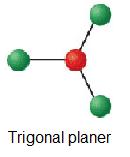 | 120° | COthree 2 - |
| ane | AX2E |  | 120° | O3 | ||
| 4 | tetrahedral | 0 | AX4 | Tetrahedral | 109.5° | S0iv two - |
| 1 | AX3E | 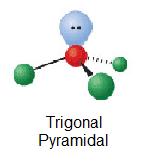 | 109.5° | H3O+ | ||
| two | AXtwoEastward2 | 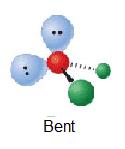 | 109.5° | H2O | ||
| 5 | trigonal-bipyramidal | 0 | AXfive | 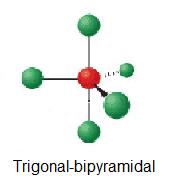 | 90°, 120° | PFv |
| 1 | AX4Eb | 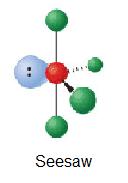 | 90°, 120° | TeCl4 | ||
| 2 | AXiiiEii | 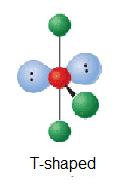 | 90° | ClFiii | ||
| three | AX2Ethree |  | 180° | I3 - | ||
| 6 | octahedral | 0 | AXvi | octahedral | xc° | PF6 - |
| ane | AX5Due east |  | 90° | SbCl5 2 - | ||
| 2 | AX4Eii | 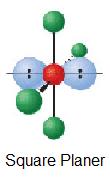 | 90° | ICl4 - |
Example \(\PageIndex{one}\):
Lets try determining the geometric structures of H2O and CO2. So starting off by cartoon the Lewis structure:
HtwoO:
Water has four electron groups and then it falls nether tetrahedral for the electron-group geometry. The four electron groups are the 2 single bonds to Hydrogen and the two lone pairs of Oxygen. Since water has two lone pairs it'due south molecular shape is bent. According to the VSEPR theory, the electrons want to minimize repulsion, and so as a result, the solitary pairs are next from each other.
CO2:
Carbon dioxide has two electron groups and no lone pairs. Carbon dioxide is therefore linear in electron-grouping geometry and in molecular geometry. The shape of COii is linear because there are no lone pairs affecting the orientation of the molecule. Therefore, the linear orientation minimizes the repulsion forces.
Molecules with More than One Central Atom
The VSEPR theory non only applies to 1 central atom, but it applies to molecules with more than than i central atom. We have in account the geometric distribution of the terminal atoms around each primal atom. For the final description, nosotros combine the separate description of each atom. In other words, we take long concatenation molecules and suspension information technology downwardly into pieces. Each piece will form a item shape. Follow the instance provided beneath:
Butane is C4H10. C-C-C-C is the simplified structural formula where the Hydrogens (non shown) are implied to take single bonds to Carbon. You tin view a better structural formula of butane at en.Wikipedia.org/wiki/File:Butane-2D-apartment.png
If we break down each Carbon, the primal atoms, into pieces, we can make up one's mind the relative shape of each section. Let's get-go with the leftmost side. We encounter that C has three single bonds to two Hydrogens and one single bond to Carbon. That means that we accept 4 electron groups. By checking the geometry of molecules chart above, we take a tetrahedral shape. Now, we motion on to the side by side Carbon. This Carbon has 2 single bonds to 2 Carbons and 2 single bonds to two Hydrogens. Once more, we take four electron groups which result in a tetrahedral. Continuing this trend, nosotros have another tetrahedral with single bonds attached to Hydrogen and Carbon atoms. As for the rightmost Carbon, nosotros likewise have a tetrahedral where Carbon binds with i Carbon and 3 Hydrogens.
Let me recap. Nosotros took a wait at butane provided by the wonderful Wikipedia link. We, and so, bankrupt the molecule into parts. Nosotros did this by looking at a particular central cantlet. In this example, we have 4 central atoms, all Carbon. By breaking the molecule into 4 parts (each part looks at 1 of the 4 Carbons), we make up one's mind how many electron groups there are and find out the shapes.
Nosotros aren't washed, however! We need to determine if at that place are any lone pairs because we only looked at bonds. Remember that electron groups include lone pairs! Butane doesn't have any lone pairs. Hence, nosotros take 4 tetrahedrals. Now, what are we going to do with four tetrahedrals? Well, nosotros want to optimize the bond angle of each central cantlet attached to each other. This is due to the electrons that are shared are more likely to repel each other. With iv tetrahedrals, the shape of the molecule looks like this: en.Wikipedia.org/wiki/File:Butane-3D-balls.png. That means that if we look dorsum at every individual tetrahedral, nosotros match the key Carbon with the Carbon information technology's bonded to.
Bond Angles
Bail angles likewise contribute to the shape of a molecule. Bail angles are the angles between adjacent lines representing bonds. The bail angle can help differentiate between linear, trigonal planar, tetraheral, trigonal-bipyramidal, and octahedral. The ideal bail angles are the angles that demonstrate the maximum angle where it would minimize repulsion, thus verifying the VSEPR theory.
Essentially, bail angles is telling us that electrons don't similar to be nearly each other. Electrons are negative. Ii negatives don't concenter. Permit's create an analogy. Generally, a negative person is seen equally bad or mean and you don't want to talk to a negative person. One negative person is bad enough, simply if you have 2 put together...that's only horrible. The two negative people will exist hateful towards each other and they won't like each other. And then, they will exist far away from each other. Nosotros can utilize this idea to electrons. Electrons are alike in charge and will repel each other. The farthest way they tin can get abroad from each other is through angles. Now, let's refer back to tetrahedrals. Why is it that xc degrees does not work? Well, if we describe out a tetrahedral on a 2-D airplane, then we get xc degrees. All the same, we live in a 3-D world. To visualize this, think almost movies. Movies in 3D pop out at us. Before, nosotros encounter movies that are just on the screen and that'due south practiced. What'southward better? 3D or 2D? For bond angles, 3D is amend. Therefore, tetrahedrals have a bond angle of 109.5 degrees. How scientists got that number was through experiments, but we don't need to know too much detail because that is not described in the textbook or lecture.
Using the example higher up, we would add that H2O has a bail angle of 109.5° and COii would have a bond angle of 180°.
Steps Used to Find the Shape of the Molecule
To sum up there are four uncomplicated steps to apply the VSEPR theory.
- Depict the Lewis Structure.
- Count the number of electron groups and identify them as bond pairs of electron groups or lonely pairs of electrons. Recall electron groups include not only bonds, simply besides solitary pairs!
- Name the electron-group geometry. (State whether it is linear, trigonal-planar, tetrahedral, trigonal-bipyramidal, or octahedral.)
- Looking at the positions of other atomic nuclei around the key determine the molecular geometry. (Come across how many lone pairs at that place are.)
Dipole Moments
A molecule is polar when the electrons are non distributed as and the molecule has two poles. The more electronegative end of the molecule is the negative end and the less electronegative end is the positive stop. A common example is HCl. Using the capital sigma + or - equally a symbol to show the the positive end and the negative terminate nosotros tin describe the internet dipole. So sigma + would be on the hydrogen atom and sigma - would be on the Chlorine atom. Using the cross bow arrow shown below we can show that it has a net dipole. The net dipole is the measurable, which is called the dipole moment. Dipole moment is equal to the product of the partial charge and the altitude. The equation for dipole moment is as follows.
\[ \mu = \delta \times d\]
with
- µ = dipole moment ( debye )
- δ = fractional accuse (C)
- d = distance (m)
The units for dipole is expressed in debye which is also known as Coulombs x meter (C x yard)
Example of a Dipole
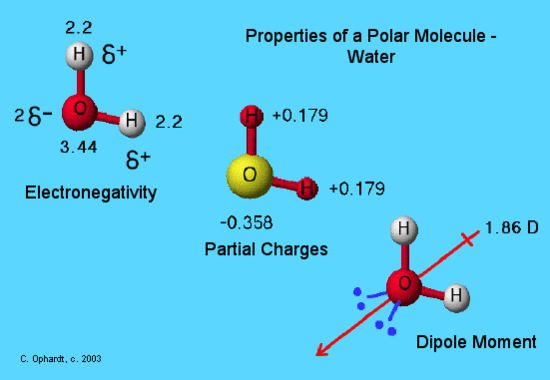
The cross base arrow demonstrates the net dipole.
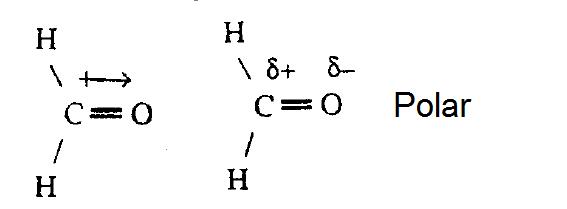
On the cantankerous-base arrow, the cross represents the positive charge and the arrow represents the negative charge.
Hither'due south another way to determine dipole moments. We need to comprehend electronegativity which is abbreviated EN. What is EN? Well, EN is how much an chemical element actually wants an electron. Think about basketball and how 2 players laissez passer the ball to each other. Each role player represent an element and the ball represents the electron. Let's say one role player is a ball hog. The player that is the brawl hog is more than electronegative considering he or she wants the ball more than.
Here is a link that has all the EN listed: world wide web.green-planet-solar-energy...electroneg.gif
What if we are not given EN? Luckily, there is a trend in the periodic table for EN. From bottom to the top, EN will increment. From left to correct, EN will increase. The most electronegative element is Flourine with iv.0.
Now, nosotros are ready to apply EN to make up one's mind whether or not molecules are polar. We expect back at the picture of HtwoO above. The EN is given. What do we practise with all the EN? Nosotros compare the EN between each bond. Oxygen has a greater EN than Hydrogen. Therefore, nosotros can draw a cross bow arrow towards Oxygen. We take two arrows because Oxygen is bonded to two Hydrogens. Since both arrows bespeak toward Oxygen, we can say that there is a net EN. Nosotros added the arrows that point to Oxygen and nosotros end up with a new, bigger arrow. This is examplified in the picture higher up. If arrows are fatigued abroad from each other like <--- and --->, and then we are more likely to have no net EN considering the molecule is symmetrical. Refer back to the Lewis dot diagram of COtwo. The shape is linear and the EN arrows point towards Oxygen. The arrows are reverse of each other and have the same EN difference. Therefore, nosotros have no internet charge and the molecule is non-polar.
Summary of Dipole Moments
To recap, when a molecule is polar it means that the electron is non distributed evenly and there is a difference in the electronegativity of the atoms. If a molecule is polar, it means that it had a net dipole which results in having a dipole moment.
Determining Polarity
Is it polar? In that location are three ways to get well-nigh determining whether a molecule is polar or not.
A. If the molecule has a cyberspace dipole, and so it is polar.
B. If the structure is symmetric, then it is non-polar
C. At that place are three rules to this role:
1. When there are no lone pairs on the heart atom, then the molecule is non-polar
2. If it is linear or square planar, and then it is non-polar. (This rule is more than important than rule 1, so it overrules it because it has lone pairs.)
three. If it has unlike terminal atoms, then it is polar. (This dominion overrules rule 1 and 2 because it is more important.)
References
- Petrucci, Ralph H., William Due south. Harwood, F. Geoffrey Herring, & Jeffry D. Madura, Full general Chemistry, Principles and Modernistic Appplications Ninth Edition, Upper Saddle River, New Jersey
- Tetrahedrality" and the Relationship between Collective Structure and Radial Distribution Functions in Liquid Water P. E. Bricklayer and J. Westward. Brady J. Phys. Chem. B;2007
- Inverted geometries at carbon Kenneth B. Wiberg Acc. Chem. Res.; 1984
- "Molecular Geometries." Chemistry Foundations and Applications. Volume 3. Farmington, MI:Lagowski, J.J., 2004.
Problems
Function I
Draw the Lewis Structure and name the shape of each compound. Also determine the polarity and whether or not it has a dipole moment.
- HClOthree
- SOthree
- PCl4
- CiiH4
- SnCl3 -
Office II
Name the shape and determine whether they are polar or not-polar.
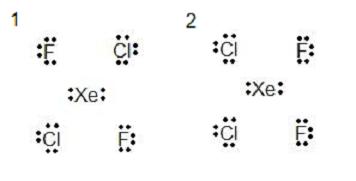
Solutions
Part I
one.

- Total # of electrons: 1+(3x6)+vii=26
- electron group geometry: tetrahedral
- molecular: trigonal pyramidal
- ideal angle: 109.v°
- polar, has a dipole moment
ii.

- Total # of electrons: (3x6)+6=24
- electronic group geometry: trigonal planar
- molecular geometry: trigonal planar
- ideal angle: 120°
- polar, has a dipole moment
3.

- Total # of electrons: (4x4)+5=19
- electronic grouping geometry: trigonal-bi-pyramidal
- molecular geometry: seesaw
- platonic angle: ninety°, 120°
- polar, has a dipole moment
4.

- Full # of electrons: (1x4)+(4x2)=12
- electronic group geometry: trigonal planar
- molecular geometry: trigonal planar
- ideal bending: 120°
- non-polar, does not have a dipole moment
5.

- Total # of electrons: (7x3)+4=26
- electronic grouping geometry: tetrahedral
- molecular geometry: trigonal pyramidal
- ideal angle: 109.5°
- polar, has a dipole moment.
Part Ii
1. electron group geometry: octahedral
molecular geometry: foursquare planar
non polar because it is symmetrical
2. electron group geometry: octahedral
molecular geometry: foursquare planar
polar considering it is not symmetrical
Bond Angle Of Trigonal Planar,
Source: https://chem.libretexts.org/Bookshelves/Physical_and_Theoretical_Chemistry_Textbook_Maps/Supplemental_Modules_(Physical_and_Theoretical_Chemistry)/Chemical_Bonding/Lewis_Theory_of_Bonding/Geometry_of_Molecules
Posted by: stevensonhimed1937.blogspot.com

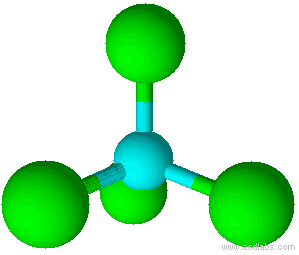
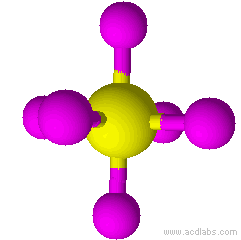

0 Response to "Bond Angle Of Trigonal Planar"
Post a Comment